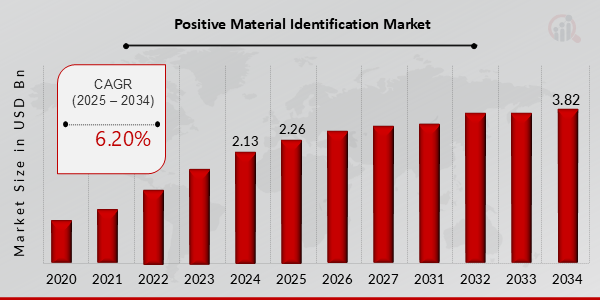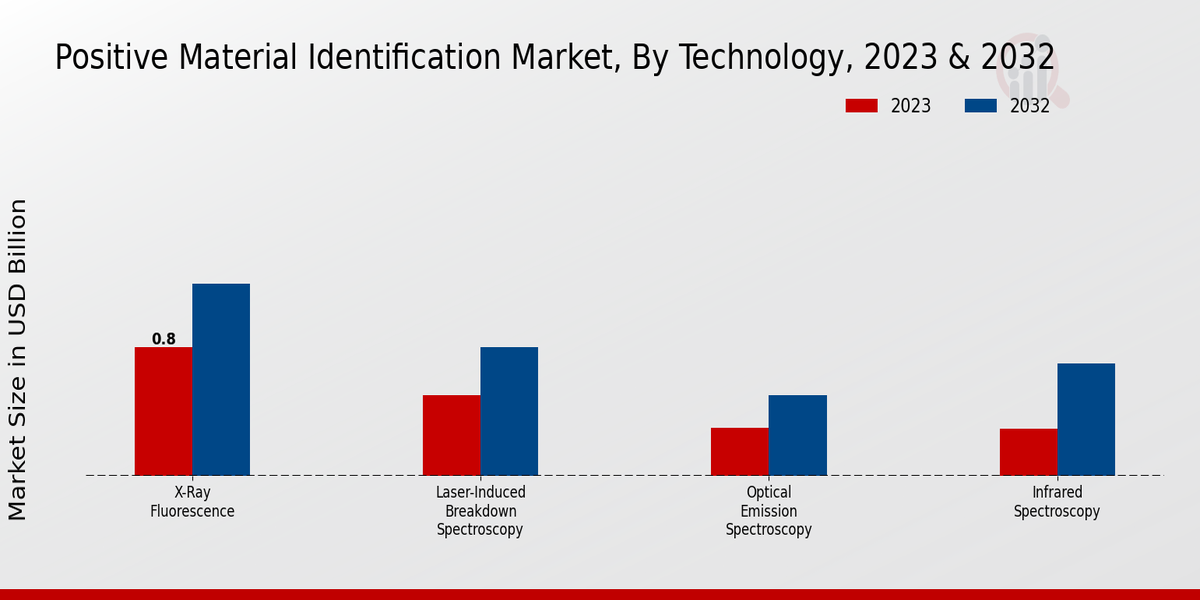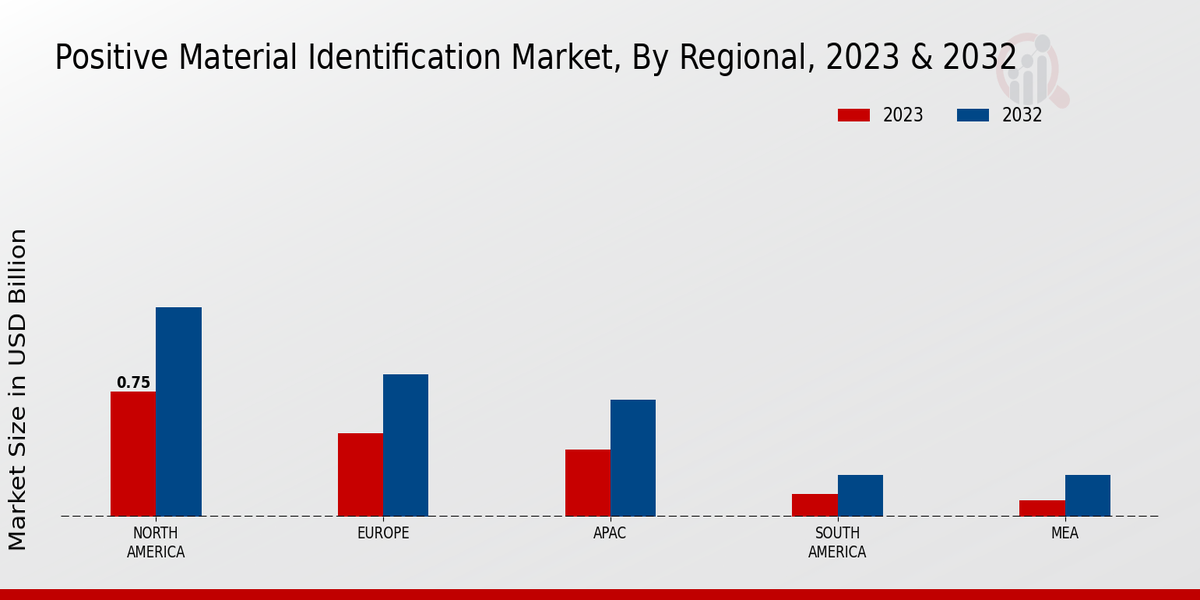Global Positive Material Identification Market Overview
Positive Material Identification Market Size was estimated at 2.13 (USD Billion) in 2024. The Positive Material Identification Market Industry is expected to grow from 2.26 (USD Billion) in 2025 to 3.82 (USD Billion) till 2034, exhibiting a compound annual growth rate (CAGR) of 6.20% during the forecast period (2025 - 2034).
Key Positive Material Identification Market Trends Highlighted
The Positive Material Identification Market is experiencing key developments driven by the increasing focus on safety and compliance across industries. Companies are prioritizing accurate material analysis to avoid costly mistakes and ensure adherence to regulations. The rise in industrial activities, especially in sectors like manufacturing, energy, and construction, further propels the demand for effective material identification tools. Additionally, advancements in technology, such as the integration of portable identification devices, enhance usability and efficiency, making it easier for organizations to implement these solutions in various environments.
There are numerous opportunities for growth in the Positive Material Identification Market. With evolving regulatory requirements for material verification, businesses can explore innovative solutions that meet these standards while improving operational efficiency. The growing trend of sustainable practices also opens avenues for developing eco-friendly identification methods. As industries increasingly incorporate advanced technologies like artificial intelligence and the Internet of Things, there is potential for creating smarter systems that provide real-time data analysis and reporting.
This can significantly improve inventory management and support better decision-making.In recent times, there has been a noticeable shift towards automation and digitization in material identification processes. Companies are adopting software solutions that integrate seamlessly with existing systems, allowing for streamlined operations and reduced manual input. Moreover, the rise of remote working conditions has spurred the demand for remote access and cloud-based identification tools, making it easier for teams to collaborate and share information. The market is also witnessing increased investments in research and development to enhance the accuracy and speed of identification methods. Overall, these trends highlight a growing awareness of the importance of precise material identification in ensuring safety, compliance, and efficiency across various sectors.

Source: Primary Research, Secondary Research, MRFR Database and Analyst Review
Positive Material Identification Market Drivers
Increasing Regulatory Compliance and Safety Standards
The growing emphasis on regulatory compliance and stringent safety standards across various industries has significantly propelled the Positive Material Identification Market Industry. Governments and regulatory bodies worldwide are enforcing regulations that require companies to ensure the integrity and quality of materials used in their processes. This is particularly pivotal in industries such as aerospace, automotive, oil and gas, and manufacturing, where the risk of material failure could lead to catastrophic events.As a result, organizations are increasingly investing in positive material identification technologies to prevent the use of incorrect materials and to streamline the verification process.
The need for compliance not only mitigates risks associated with material failures but also enhances product reliability, thereby positively influencing the market's expansion. Additionally, this trend has encouraged the development and adoption of advanced PMI technologies, including X-ray fluorescence and laser-induced breakdown spectroscopy, to meet these evolving standards.Improved training and awareness regarding material identification methods among personnel also drive the demand for effective solutions in the Positive Material Identification Market Industry.
Technological Advancements in PMI Solutions
Rapid advancements in technology have greatly enhanced the capabilities and accuracy of Positive Material Identification solutions. Innovations such as portable and handheld devices have made it easier for industries to implement PMI processes on-site. These technological improvements not only increase efficiency but also reduce costs associated with labor and time. As a result, numerous industries are adopting advanced PMI technologies, thereby fueling growth in the Positive Material Identification Market Industry.
Growing Awareness of Material Quality and Traceability
There is an increasing recognition within various sectors regarding the importance of material quality and traceability. Organizations are becoming more aware that identifying and verifying materials early in the supply chain can prevent costly errors and enhance product quality. This growing awareness is contributing to a higher demand for positive material identification solutions, which is expected to continue driving the Positive Material Identification Market Industry in the years to come.
Positive Material Identification Market Segment Insights:
Positive Material Identification Market Technology Insights
The Positive Material Identification Market within the Technology segment is experiencing noteworthy growth, driven by an increasing need for material verification and safety compliance across various industries. In 2023, the overall market value stands at 1.89 USD Billion, with expectations of reaching 3.2 USD Billion by 2032, indicative of robust market growth. The X-Ray Fluorescence segment holds a majority of the market share, valued at 0.8 USD Billion in 2023 and projected to expand to 1.2 USD Billion by 2032. This segment dominates due to its wide applicability in fields such as metals, recycling, and environmental monitoring, where precise chemical composition analysis is critical.Another significant segment, Laser-Induced Breakdown Spectroscopy, is calculated at 0.5 USD Billion in 2023, set to increase to 0.8 USD Billion in 2032.
This technology is recognized for its effectiveness in analyzing both solid and liquid samples, and it is making strides in various sectors like aerospace and forensic science. Optical Emission Spectroscopy, with a valuation of 0.3 USD Billion in 2023, is on its way to growth, reaching 0.5 USD Billion by 2032. This approach is noteworthy for its precision in determining metal composition, which is vital for quality control and failure analysis in manufacturing.Lastly, the Infrared Spectroscopy segment, valued at 0.29 USD Billion in 2023 and anticipated to rise to 0.7 USD Billion by 2032, is gaining traction due to its non-destructive testing capabilities and its significant role in industries like pharmaceuticals and food safety. The continuous advancements in these technologies, coupled with the rising need for regulatory compliance and safety standards, are key drivers propelling the Positive Material Identification Market, ensuring diverse applications and a promising market outlook amidst various challenges.

Source: Primary Research, Secondary Research, MRFR Database and Analyst Review
Positive Material Identification Market End User Insights
The Positive Material Identification Market, valued at approximately 1.89 billion USD in 2023, is driven by an increasing focus on safety and compliance across various sectors. The end-user landscape is diverse, encompassing critical industries such as manufacturing, construction, aerospace, and automotive. Manufacturing plays a pivotal role, with its need for precise material analysis to ensure product quality and regulatory adherence. The construction sector significantly contributes to the market by improving material verification processes and reducing project risks.
Aerospace relies heavily on Positive Material Identification due to strict regulations and safety standards, making accurate material identification essential for operational integrity. Meanwhile, the automotive industry, which is experiencing rapid advancements in technology and safety measures, is increasingly adopting material verification processes to enhance product reliability. Collectively, these sectors represent a substantial share of the market, highlighting the importance of effective material identification solutions to address specific industry challenges, ensure compliance, and capitalize on emerging opportunities across the Positive Material Identification Market landscape.
Positive Material Identification Market Application Insights
The Positive Material Identification Market, valued at 1.89 billion USD in 2023, showcases a diverse range of applications critical for various industries. Within this market, significant applications include Quality Control, Material Verification, Compliance Testing, and Recycling, each contributing uniquely to operational efficiency. Quality Control supports industries such as manufacturing and construction by ensuring materials meet specified standards, reducing the likelihood of defects. Material Verification plays an essential role in sectors like aerospace and automotive, where the integrity of materials is paramount for safety and performance.
Compliance Testing has become increasingly important due to stringent regulatory standards, making it essential for businesses to validate material properties and ensure adherence to industry guidelines. Recycling applications are also gaining traction, driven by sustainability initiatives, as they facilitate the identification of materials suitable for reuse, thus promoting responsible waste management. As the market evolves, these applications are expected to be pivotal in driving growth, addressing challenges, and enhancing operational capabilities across sectors, contributing prominently to the Positive Material Identification Market revenue.
Positive Material Identification Market Product Type Insights
The Positive Material Identification Market is poised for significant growth, with a market valuation reaching approximately 1.89 USD Billion in 2023 and projected to grow substantially by 2032. Within this market, the Product Type segment plays a crucial role, comprising various devices essential for material identification tasks. Handheld devices, widely utilized for their portability and user-friendly design, have gained traction in sectors requiring quick and efficient identification in field conditions. Desktop devices cater to industries that demand precision and detailed analysis in laboratory settings, thus representing a vital component of the market.Additionally, portable analyzers are becoming increasingly prominent due to their versatility and ability to deliver reliable results in various environments.
The convergence of these device types not only drives the overall market but also reflects a trend toward adopting advanced technologies that improve operational efficiency. Factors such as the increasing need for safety, compliance with industry standards, and technological advancements are propelling market growth while presenting challenges like high initial investment costs and the need for skilled operators.Overall, the Positive Material Identification Market segmentation indicates a robust landscape with evolving opportunities across different device types, enhancing its relevance in various industries.
Positive Material Identification Market Regional Insights
The Positive Material Identification Market is valued at 1.89 USD Billion in 2023 and is forecasted to experience notable growth across its regional segmentation. North America holds a majority share, valued at 0.75 USD Billion in 2023, and is projected to reach 1.25 USD Billion by 2032, driven by its strong industrial base and advanced technological adoption. Europe follows closely with a market value of 0.5 USD Billion in 2023, expected to rise to 0.85 USD Billion by 2032, fueled by stringent regulatory standards and increased focus on material safety.
The APAC region, valued at 0.4 USD Billion in 2023, is also slated to grow significantly, reaching 0.7 USD Billion by 2032, owing to rapid industrialization and the growing demand for raw material analysis. South America and MEA are at the lower end of the market spectrum, with valuations of 0.14 USD Billion and 0.1 USD Billion in 2023, respectively, but are anticipated to grow steadily, highlighting emerging opportunities. The Positive Material Identification Market statistics reflect a rising trend in material identification technologies as industries seek enhanced safety and compliance, signifying a robust and evolving landscape across these regions.

Source: Primary Research, Secondary Research, MRFR Database and Analyst Review
Positive Material Identification Market Key Players and Competitive Insights:
The Positive Material Identification Market is experiencing significant growth, driven by the increasing demand for material analysis and quality assurance across various industries, including manufacturing, construction, and aerospace. As the industry evolves, competition intensifies, leading to the emergence of innovative technologies and solutions to meet market needs. Key players are focusing on advancements in spectroscopic techniques, such as X-ray fluorescence and optical emission spectrometry, to enhance material identification accuracy and efficiency. Additionally, factors such as regulatory compliance, safety standards, and the need for environmentally sustainable practices are shaping the competitive landscape. Companies are also investing in research and development to create advanced portable devices and software solutions that enable real-time analysis, reflecting the dynamic nature of the market and the necessity for companies to adapt to market innovations and customer demands.
Cameca is recognized for its robust presence in the Positive Material Identification Market, leveraging state-of-the-art technologies to deliver high-performance analytical solutions. The company excels in providing accurate and efficient elemental analysis, catering to a diverse clientele across various sectors. Strengths of Cameca include its commitment to research and development, which allows for continuous innovation in material identification instruments. Additionally, Cameca's reputation for quality and reliability has positioned it as a preferred choice among industry professionals seeking precise and dependable analysis tools. Their strong focus on customer support and service further enhances their competitive advantage, enabling them to foster long-term relationships with clients and provide tailored solutions that meet specific industry needs.Bruker stands out in the Positive Material Identification Market with its innovative technologies and comprehensive range of analytical instruments.
The company is renowned for its cutting-edge solutions that cater to a wide array of applications, making it a key player in the material identification landscape. Bruker’s strengths lie in its relentless pursuit of excellence in product development and its ability to integrate advanced spectroscopy techniques into user-friendly systems. This ensures high efficiency and accuracy in material analysis, appealing to customers looking for reliable solutions. Additionally, Bruker's dedication to expanding its technological offerings through strategic partnerships and collaborations further solidifies its position in the market. With a strong emphasis on customer satisfaction, Bruker effectively addresses market demands and maintains a competitive edge through continuous innovation and expertise in material characterization.
Key Companies in the Positive Material Identification Market Include:
- Cameca
- Bruker
- Leica Microsystems
- Hitachi HighTech
- KARL STORZ
- Thermo Fisher Scientific
- Agilent Technologies
- Olympus
- PerkinElmer
- XRite
- Mettler Toledo
- Boeing
- Siemens
- Oxford Instruments
- Horiba
Positive Material Identification Market Industry Developments
The Positive Material Identification Market has been witnessing notable developments lately. Companies such as Thermo Fisher Scientific and Bruker are investing heavily in the advancement of their material identification technologies, contributing to market growth. Recent innovations in spectroscopy and X-ray fluorescence are enhancing the capabilities of positive material identification solutions, offering industries more efficient ways to analyze and verify materials. Additionally, collaborations among key players, including Leica Microsystems and Agilent Technologies, are fostering advancements in analytical instrument capabilities.
In terms of mergers and acquisitions, both Olympus and Hitachi High-Tech have been active, with recent reports confirming strategic acquisitions aimed at expanding their technological prowess and market reach. The valuation of companies like XRite and PerkinElmer has been positively impacted by increasing demand for high-precision material identification solutions across sectors such as aerospace, manufacturing, and environmental analysis. As compliance regulations escalate globally, the market is positioning itself for further growth, driven by the urgent need for accurate material analysis in maintaining safety standards and enhancing operational efficiencies.
Positive Material Identification Market Segmentation Insights
-
Positive Material Identification Market Technology Outlook
- X-Ray Fluorescence
- Laser-Induced Breakdown Spectroscopy
- Optical Emission Spectroscopy
- Infrared Spectroscopy
-
Positive Material Identification Market End User Outlook
- Manufacturing
- Construction
- Aerospace
- Automotive
-
Positive Material Identification Market Application Outlook
- Quality Control
- Material Verification
- Compliance Testing
- Recycling
-
Positive Material Identification Market Product Type Outlook
- Handheld Devices
- Desktop Devices
- Portable Analyzers
-
Positive Material Identification Market Regional Outlook
-
North America
-
Europe
-
South America
-
Asia Pacific
-
Middle East and Africa
| Report Attribute/Metric |
Details |
|
Market Size 2024
|
USD 2.13 Billion
|
|
Market Size 2025
|
USD 2.26 Billion
|
|
Market Size 2034
|
USD 3.82 Billion
|
|
Compound Annual Growth Rate (CAGR)
|
6.20% (2025-2034)
|
| Report Coverage |
Revenue Forecast, Competitive Landscape, Growth Factors, and Trends |
|
Base Year
|
2024
|
|
Market Forecast Period
|
2025-2034
|
|
Historical Data
|
2020-2023
|
| Market Forecast Units |
USD Billion |
| Key Companies Profiled |
Cameca, Bruker, Leica Microsystems, Hitachi HighTech, KARL STORZ, Thermo Fisher Scientific, Agilent Technologies, Olympus, PerkinElmer, XRite, Mettler Toledo, Boeing, Siemens, Oxford Instruments, Horiba |
| Segments Covered |
Technology, End User, Application, Product Type, Regional |
| Key Market Opportunities |
Growing regulations on material safety, Advancements in handheld devices, Increasing demand in the construction sector, Rising need for recycling compliance, Integration with IoT technologies |
| Key Market Dynamics |
Increasing safety regulations, Growing demand for lightweight materials, Advancements in spectroscopy technology, Rising concerns over material traceability, Expanding industrial applications |
| Countries Covered |
North America, Europe, APAC, South America, MEA |
Frequently Asked Questions (FAQ) :
The Positive Material Identification Market is expected to reach a value of 3.82 USD Billion by 2034.
In 2025, the Positive Material Identification Market is valued at 2.26 USD Billion.
The expected CAGR for the Positive Material Identification Market from 2025 to 2034 is 6.20%.
By 2032, North America is projected to hold the largest share in the Positive Material Identification Market.
The projected market value for North America in 2032 is approximately 1.25 USD Billion.
The X-Ray Fluorescence technology segment is expected to dominate the market by reaching 1.2 USD Billion in 2032.
The Optical Emission Spectroscopy segment is valued at 0.3 USD Billion in 2023 and is expected to reach 0.5 USD Billion by 2032.
Major players in the market include Cameca, Bruker, and Thermo Fisher Scientific among others.
The Infrared Spectroscopy technology segment is expected to reach a value of around 0.7 USD Billion by 2032.
Challenges may include advancements in technology and competition among key players in the market.

















